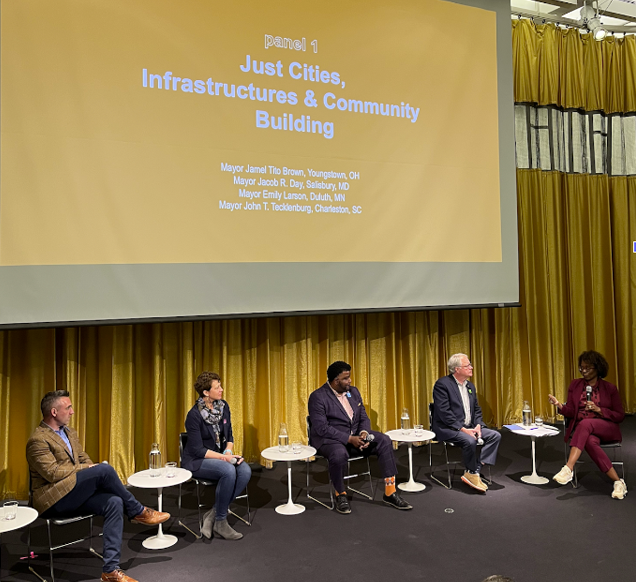How Mayors Are Using Infrastructure and Community-Building to Address Injustice
Policymakers and designers recently joined together in the second annual Mayors Imagining the Just City Symposium. Now is the time to celebrate innovative programs like these and see them as necessary in advancing equity in the policy space.
How Mayors Are Using Infrastructure and Community-Building to Address Injustice
Recent survey data from Next100 and GenForward shows that young adults’ trust in government, from the federal level down to the local, is critically low. Even at the local level, which shows the highest rates of trust across all respondents, only one in three young adults (34 percent) say they trust their local government. For Black young adults it’s 23 percent. For respondents with incomes below $60,000 it’s 28 percent.

From left to right: Mayor Jacob R. Day (Salisbury, Maryland), Mayor Emily Larson (Duluth, Minnesota), Mayor Jamael Tito Brown (Youngstown, Ohio), Mayor John T. Tecklenburg (Charleston, South Carolina), Professor Toni L. Griffin (founder of urbanAC and founder and director of The Just City Lab). Harvard University Graduate School of Design, Cambridge, Massachusetts, April 22, 2022.
These data are not surprising. The U.S. policy space has always been majority white, male, and wealthy, not reflective of the majority of the country or our needs. Consequences of this exclusionary status quo include violent, traumatic policy decisions that, whether through action or inaction, bring disproportionate harm to the health and well-being of underserved communities. This is not okay. We are not okay.
There is so much work to be done, but one important piece of that work can be contributed by city halls themselves. Last month, I had the opportunity to take part in the second annual Mayors Imaging the Just City symposium at Harvard University’s Graduate School of Design (GSD), and hear directly from mayors who see it as part of their role to acknowledge and address injustice in their cities—and their city halls—in order to build more equitable outcomes. Also present were designers of buildings and public spaces with the same commitment.
This collaboration between designers and government is critical. If we care about designing more just and equitable cities, we need to have policymakers and designers work together: justice and equity require a new type of policy space. Physical space and design matter—and policy in pursuit of equity needs to acknowledge and support that fact.
This symposium—and this set of mayors and designers—was a demonstration of what it can look like for policymakers and designers to work together in pursuit of equitable public physical spaces, which in turn can lead to more equitable versions of the public policies that impact us all.
Having Policymakers and Designers Work Together Helps Turn Talk About Justice into Action Felt on the Ground
As Mayor Jacob R. Day of Salisbury, Maryland, said at the symposium, “The beauty of design and policy is not only that you appreciate the making of these spaces, but you’ve also gone through an education that has taught you how to ultimately stop the planning and start making and start doing. At some point you gotta build that final model.”
The Mayors Imaging the Just City symposium is an exciting example of how much we can learn and accomplish when we work together in a cross-disciplinary fashion, centering the people most impacted and valuing their lived experiences. The symposium celebrates the culmination of the Mayors Institute on City Design (MICD)’s Just City Mayoral Fellowship, a collaboration between MICD and the GSD’s Just City Lab. Partners include both the GSD and MICD along with The National Endowment for the Arts and the United States Conference of Mayors.
Over the course of the eight weeks leading up to the symposium, the fellowship made space for the participating local policymakers—mayors from across the country—to meet with artists, designers, urban planners, and architects to “discuss strategies for using planning and design interventions to address racial injustice in each of their cities.” (A full recording of the symposium can be accessed here.) Together, mayors and designers navigated how to ground values of justice and equity in their cities.
Key Takeaways from the Symposium
During the first panel, “Just Cities, Infrastructures, and Community Building,” I had the privilege of asking mayors to share ways they are working to ensure marginalized communities feel welcomed and centered in the public policy space of city hall. Their responses had the following common themes.
1. Have equitable hiring practices at City Hall, so that staff truly represents the people it serves.
As Mayor Jamael Tito Brown of Youngstown, Ohio, said, “I pride myself on making sure that my cabinet looks like me… I am the fifty-first mayor but only the second African-American mayor in my city’s history… and we are probably 50 percent African-American in my community… you always have to start somewhere and continue pushing forward.”
The importance of this work aligns with that same survey data from Next100 and GenForward that also found, “more than three in five young adults would be more likely to trust government leaders if they were from their community.” As Mayor Emily Larson of Duluth, Minnesota, said, “If you feel you can see yourself [in City Hall], you will be there… push public entities to be hiring people who look like the community, that are the community, that are the community they’re becoming because you can also have this very comfortable space and still not see yourself in it.”
This theme also aligns with the comprehensive recommendations outlined in the Next100 toolkit published earlier this month, “How to Build a More Diverse, Inclusive, and Effective Policy Sector.” One of the many things that the COVID-19 pandemic has made clear to me is the importance of clear, accessible, and well-translated government resources—in digital spaces as well as in physical ones. Designers play a key role in policy spaces, and it is critical that cities hire diverse designers who understand nuance and have an acute awareness of what symbols, materials, and even colors can mean to the communities they serve. As in the policy making space, there has been a long history of design, architecture, and planning fields being predominantly white, male, and wealthy, not representing the people and, in turn, causing extreme harm to them.
2. Have diverse and inclusive artwork at City Hall, especially in the entryway.
As Mayor Larson said, “Public spaces are one thousand percent for the public. And so that’s [for example] through public art… When I first came into office, there was a hall of mayors. I am the first female, and all these large old paintings—white men, smoking—we took them down, which really made people mad. We found a way to honor the service… but if we’re going to have a space that works for everybody we need to both honor the heritage and move forward on who the space is going to be for… Space does matter.”
3. Actively invite the community into City Hall.
As Mayor Larson said, “we invite a lot of people into the building.”
There were other innovative examples spotlighted. An excellent example came from the leadership of Mayor Patrick Wojahn of College Park, Maryland, a city whose residents and elected officials have been talking for over twenty years about the need to improve City Hall. This past December, College Park celebrated completing their new LEED-Certified City Hall, which includes a makerspace, more community meeting rooms, University of Maryland offices, outdoor gathering spaces, ground-level retail, and outdoor dining. The concept behind this new building design is that if there is a diversity of activities and ways to engage with the building, beyond what we traditionally consider to be the purpose of government spaces, more people will come to City Hall. Makerspaces in particular facilitate collaboration, creativity, and community building – critical skills needed in the policy space in order to build more just societies. (More on the design process for College Park’s City Hall can be found here.)
Holistic Change Requires Wholehearted Commitment
Mayors and designers across the country are working together on innovative policy solutions to address a lack of equity and justice in our cities—and they are spatializing this work in their very own City Halls. Collaborative symposia like Mayors Imagining the Just City are new, energizing opportunities that highlight the importance of working together so we can meet the challenges impacting our most vulnerable communities today. It’s my hope that with policymakers and designers working together in this way—the call and response, “Show me what democracy looks like! This is what democracy looks like!”—will not only be shouted in the streets as we march to City Hall, stopping short at the gates and steps, but will ring true for us inside the building itself.
This symposium demonstrated the power of policymakers and designers working together in pursuit of equitable policy spaces, which lead to more equitable public policies. But it’s just a start. Truly changing physical spaces takes time and multiple election cycles and leaders in a row who are committed to this cause. That foundational commitment to change—to address deep seated injustice—must be supported through longer-term policy incentives and funding, to ensure we keep building on the work.

